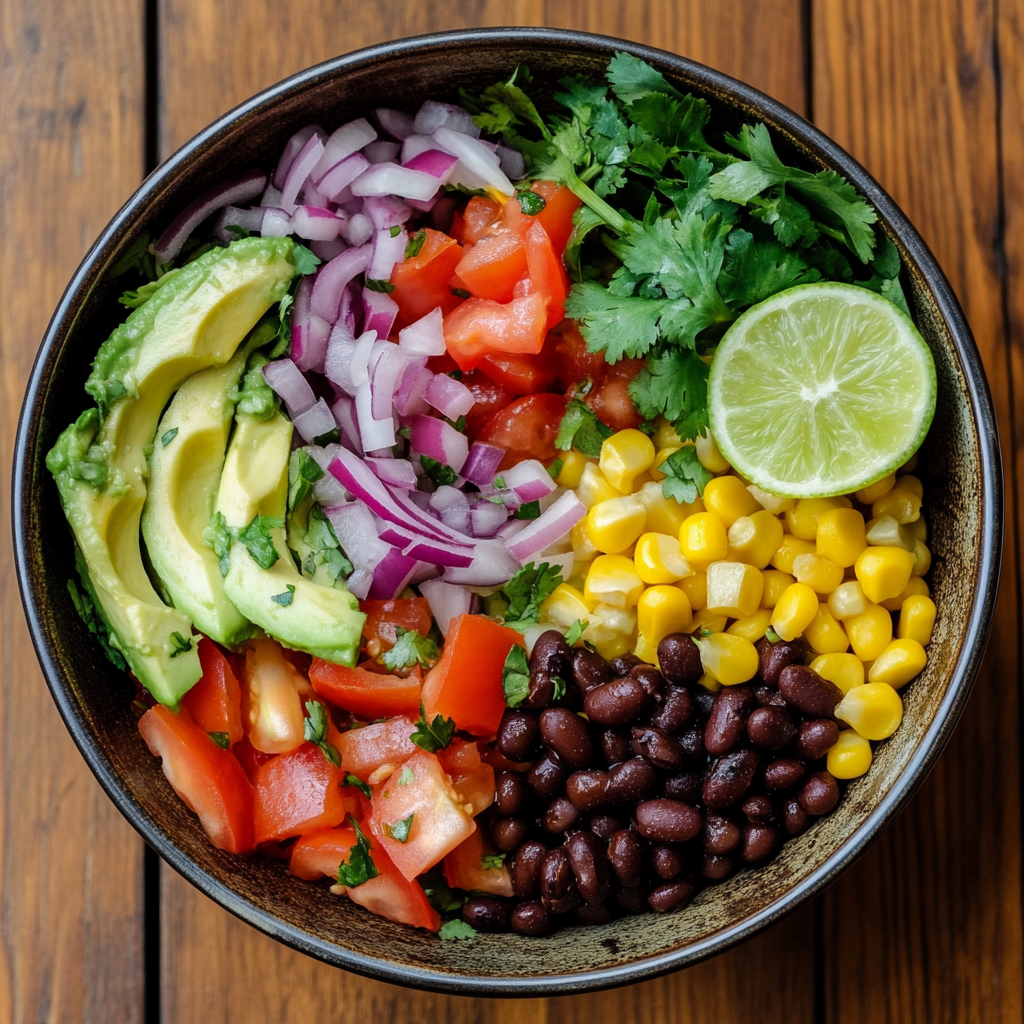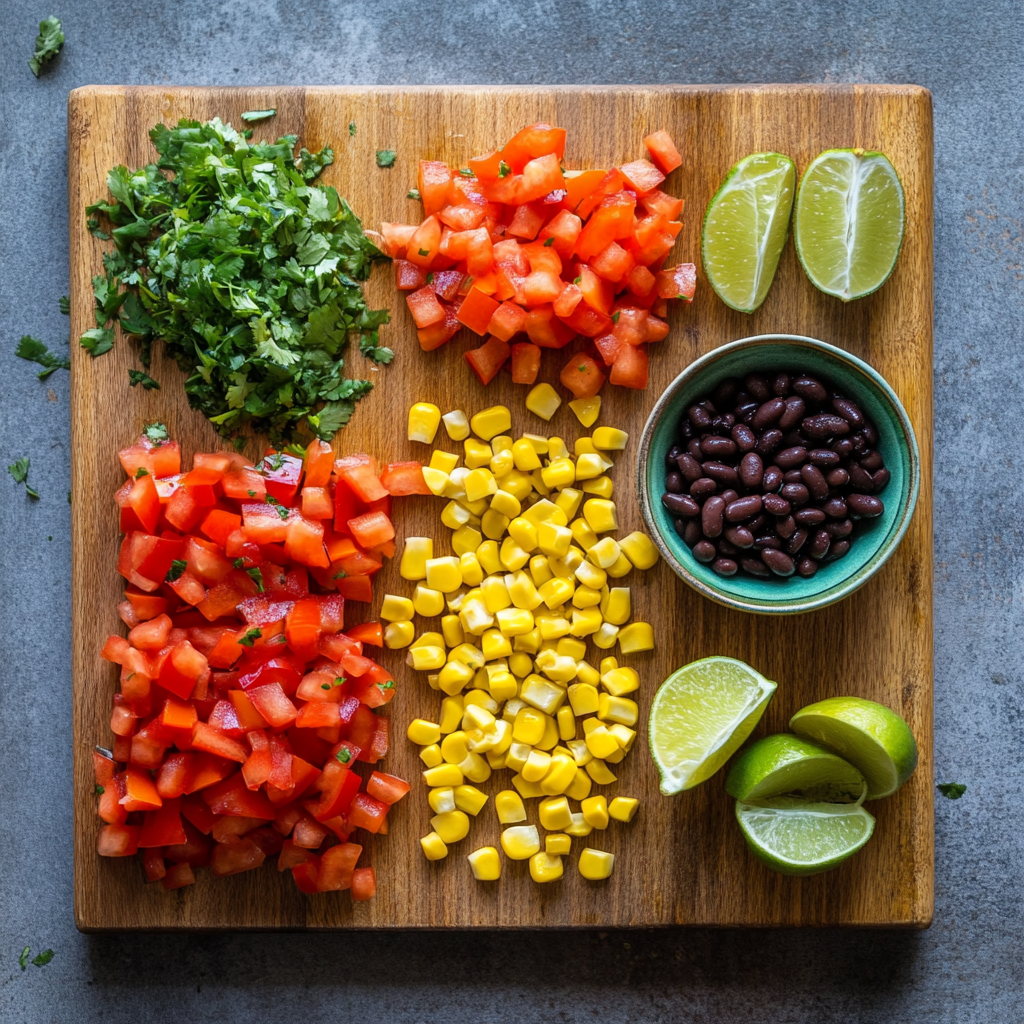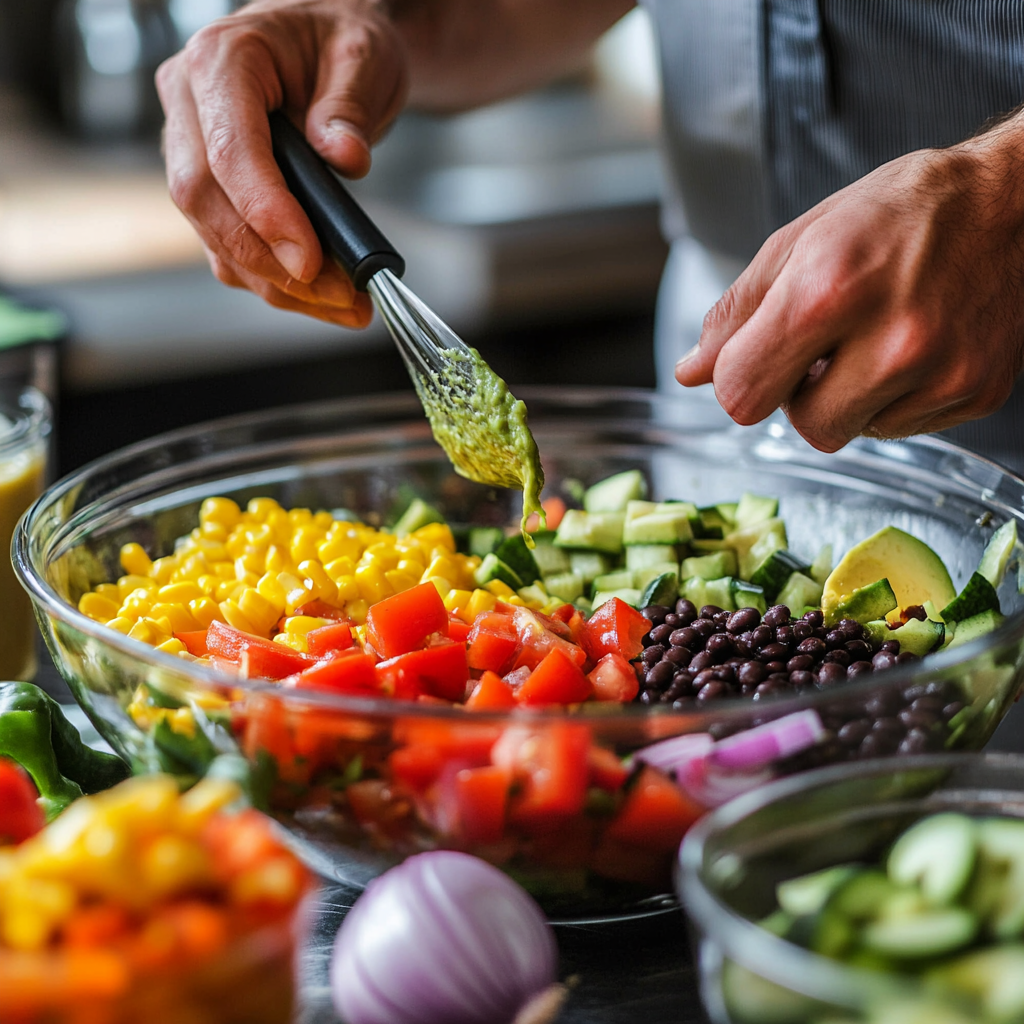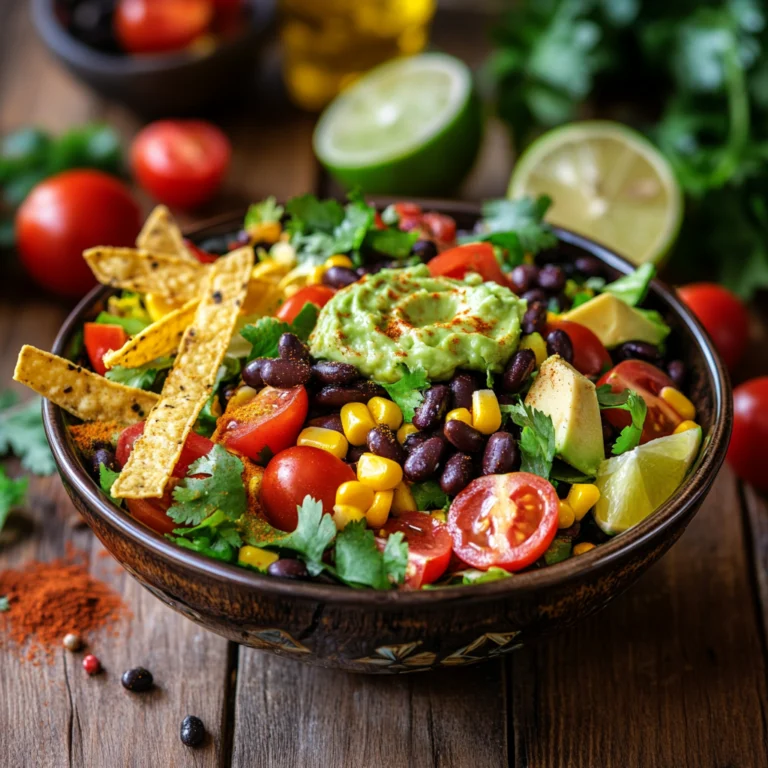Introduction
Mexican salads are not only a wonderful mix of bright colors, fresh foods, and bold tastes but also a true reflection of Mexican cooking. These salads are packed with vegetables, protein, and tasty dressings, making them easy to make, healthy, and good for different diets. In addition to being flexible, they can be easily adjusted to fit personal tastes or diet needs. In this article, we’ll look at what a Mexican salad is made of, review its main ingredients, discuss options, talk about its health benefits, and even give tips for making it at home. So, let’s jump in and discover the secrets of this great dish!
Table of contents
- Introduction
- Introduction to Mexican Salad
- What is a Mexican Salad Made Of?
- Core Ingredients of a Traditional Mexican Salad
- Variations of Mexican Salad
- Health Benefits of Mexican Salad
- Nutritional Content of Mexican Salad (Per 100g)
- How to Make a Mexican Salad at Home
- FAQs About Mexican Salad
- Conclusion and Serving Suggestions
Introduction to Mexican Salad
What is a Mexican Salad Made Of?
A Mexican salad is not only a zesty and tasty dish but also a great mix of fresh vegetables, protein, and flavorful dressings. It’s a true celebration of Mexican cooking, showing the country’s love for strong flavors, fresh foods, and healthy eating. Whether it’s served as a side dish, starter, or main meal, a Mexican salad always has something for everyone.
This dish usually includes a mix of juicy tomatoes, sweet corn, rich black beans, and creamy avocados, topped with a splash of lime juice. Add-ons like crispy tortilla strips or grilled meats are often included, making it an easy and adjustable recipe for any occasion.
Why Mexican Salad is Popular Worldwide
There’s no doubt that Mexican food has a worldwide appeal, and salads are no exception. People love Mexican salads because they’re not only delicious but also filled with healthy ingredients. They easily fit into many cuisines and diet styles. For example, from gluten-free options to vegan twists, these salads have found a place in kitchens around the world.
Moreover, the balance of flavors and textures—from the crunch of fresh vegetables to the creaminess of avocado—is simply irresistible. As a result, it’s no wonder that Mexican salads have gained popularity in homes, restaurants, and even on food trucks worldwide.
Core Ingredients of a Traditional Mexican Salad
A Mexican salad isn’t just a dish; it’s a mix of taste, texture, and health. Its main parts work together, creating a balance that’s both filling and flexible. Let’s break it down, step by step, and see what makes this salad so special.
Fresh Vegetables in Mexican Salad
Vegetables are the heart and soul of a traditional Mexican salad. Their vibrant colors and crisp textures set the tone for this dish.
Tomatoes: Juicy, flavorful, and rich in vitamins
Tomatoes bring a juicy, tangy burst of flavor to every bite. Whether you use Roma, cherry, or special types, their natural sweetness works well with other strong parts of the salad. Plus, they’re packed with vitamins C and K, making your salad both tasty and healthy.
Corn: Adds sweetness and crunch
Corn is clearly an important part of Mexican salads, as it provides not only a little sweetness but also a pleasing crunchy texture. Freshly cooked kernels or grilled corn can add a smoky flavor that makes the dish stand out. Along with its flavor and texture, corn is also a good source of fiber and healthy nutrients, making it both delicious and good for you.
Bell Peppers: Varieties and their use
Bell peppers come in a rainbow of colors, each with its unique flavor. For example, red peppers are sweet, yellow ones are mild, and green peppers have a slightly bitter taste. Whether sliced thin or diced small, they not only add a nice crunch but also bright colors to the salad, improving both its flavor and look.
Red Onions: A zesty kick to the mix
Red onions are another key player, delivering a mild yet zesty flavor. Thinly sliced rings or finely diced pieces add a touch of sharpness that contrasts beautifully with the creamier elements. Soaking them in lime juice softens their bite while boosting their tang.

Protein Sources in Mexican Salad
While the vegetables bring freshness, proteins add substance and staying power to the salad.
Black Beans: A staple ingredient
Black beans are a classic part of Mexican cuisine, as they offer both a creamy texture and an earthy flavor. They are also packed with plant-based protein and fiber, making them a great choice for vegetarian and vegan versions of the salad. Their flexibility allows them to work with many other ingredients, improving both the taste and health value of the dish.
Grilled Chicken or Beef: Common meat additions
For a more filling option, grilled chicken or beef is a great addition that works wonders. When cooked with Mexican spices such as cumin, chili powder, and garlic, the meat develops a smoky and tasty flavor that, in turn, pairs perfectly with the salad’s fresh and bright ingredients. This protein-rich choice not only improves the dish’s flavor but also makes it more satisfying.
Tofu or Tempeh: Plant-based options for vegetarians
If you’re looking for a vegetarian protein option, tofu or tempeh works well. Cooked with spices, these foods soak up the flavors and provide a firm texture without losing their taste.
Herbs and Seasonings
The magic of Mexican salads lies in their strong flavors and fresh herbs.
Cilantro: The signature herb of Mexican cuisine
Cilantro is the go-to herb in any Mexican salad. Its bright, citrus-like flavor brings all the ingredients together, adding a fresh touch that’s clearly Mexican. If you’re not a fan of cilantro, parsley can be a gentler option.
Lime Juice: Adds tangy freshness
A squeeze of lime juice is a game-changer. It sharpens the flavors, balances the richness, and adds a fresh taste that makes every bite lively.
Chili Powder or Paprika: For spice enthusiasts
A dash of chili powder or smoked paprika brings a subtle heat and earthy depth to the salad. For those who prefer a spicier kick, cayenne pepper is an excellent addition.
Dressing for Mexican Salad
The dressing is the finishing touch that ties everything together.
Creamy Avocado Dressing: A crowd favorite
This smooth and velvety dressing combines ripe avocados, lime juice, garlic, and olive oil. It’s rich without being heavy, enhancing the salad’s texture and flavor.
Simple Lime and Olive Oil Mix: Light and zesty
For a lighter option, a simple mix of lime juice and olive oil is perfect. This dressing lets the ingredients shine while adding just a hint of tangy richness.
Salsa or Vinaigrette: A bolder flavor option
For those who love bold flavors, a salsa-based dressing or tangy vinaigrette is a fantastic choice. These options pack a punch, complementing the salad’s fresh elements with a savory depth.
Variations of Mexican Salad
One of the greatest joys of Mexican salads is their flexibility. With so many regional influences and creative twists, there’s no single way to enjoy this dish. From traditional flavors to inventive adaptations, let’s explore some of the most popular variations.
Regional Variations of Mexican Salad
Mexico’s diverse culinary regions each bring their unique flair to this beloved dish.
Northern Mexico Style: Heavier on meat and cheese
In Northern Mexico, where meat plays a central role in the cuisine, salads often feature generous portions of grilled beef or chicken. As a result, these salads are hearty and satisfying. Furthermore, toppings like shredded cheese, crumbled queso fresco, or even dollops of sour cream add a creamy richness that complements the bold flavors. Ultimately, the combination of these elements creates a salad that feels like a complete and fulfilling meal.
Yucatan Style: Inclusion of tropical fruits like mango or pineapple
The Yucatan Peninsula is well-known for its bright and tropical flavors, and Mexican salads from this region often include fruits like mango, pineapple, or papaya. These fruits not only add a natural sweetness but also go well with the salad’s tangy lime dressing. Additions like pickled red onions or spicy habanero chili create a great mix of sweet and spicy, making these salads both fresh and bold.
Street Vendor Versions: Quick, crunchy, and portable
Street vendors across Mexico often serve quick and simple salads that focus on crunch. These salads usually include chopped cucumbers, jicama, and carrots, which are then flavored with lime juice, chili powder, and a pinch of salt. They are often served in throwaway cups, making them perfect for snacking on the go. As a result, these bright and tasty salads have become a popular choice for those looking for a fresh and simple treat.
Creative Twists on Mexican Salad
Mexican salads are not just about tradition—they’re also a way to try new ideas.
Vegan Mexican Salad: Exclusion of dairy and meat, emphasis on beans and avocados
For plant-based eaters, vegan Mexican salads are perfect. They skip meat and dairy, instead using healthy options like black beans, chickpeas, or quinoa. Creamy avocado takes the place of cheese, while smoky chipotle or tangy salsa works as the dressing.
Low-Calorie Mexican Salad: Skipping creamy dressings and cheese
Health-conscious diners can enjoy a low-calorie version by ditching heavy dressings and cheese. Instead, the salad relies on fresh ingredients like lettuce, spinach, or kale, combined with tomatoes, corn, and peppers. A light lime and olive oil dressing keeps it flavorful without the extra calories.
Tex-Mex Style: Adding nachos, cheddar, and sour cream
Tex-Mex salads seamlessly blend American and Mexican culinary traditions, resulting in a bold and indulgent twist. For instance, imagine crunchy tortilla chips, shredded cheddar cheese, and a dollop of sour cream piled atop a bed of fresh lettuce and vegetables. Moreover, this variation is a favorite due to its delightful mix of textures and flavors. Whether enjoyed as a standalone meal or served as a side dish, it’s a versatile and satisfying option that never disappoints.
Health Benefits of Mexican Salad
Mexican salads are not only delicious but also packed with nutrients, making them an excellent choice for a healthy lifestyle. Whether you’re looking to boost your nutrition, lose weight, or follow a specific diet, this dish offers something for everyone. Let’s delve into the key health benefits of Mexican salad ingredients.
Nutritional Profile of Mexican Salad Ingredients
Mexican salads bring together a powerhouse of nutritious components that cater to overall health and well-being.
High in fiber, vitamins, and antioxidants
The abundance of vegetables like tomatoes, bell peppers, and onions means these salads are loaded with fiber, which supports digestion and promotes a healthy gut. Vitamins A, C, and E from ingredients like avocado and corn help boost immunity, while antioxidants combat free radicals, reducing the risk of chronic diseases.
Rich protein sources for muscle health
Whether it’s black beans, grilled chicken, or tofu, the proteins in Mexican salads provide essential amino acids needed for muscle repair and growth. Plant-based proteins like beans and quinoa also contain iron and magnesium, crucial for energy production and overall vitality.
Nutritional Content of Mexican Salad (Per 100g)
Below is the approximate nutritional value of a traditional Mexican salad made with fresh vegetables, black beans, and lime dressing:
| Nutrient | Amount |
|---|---|
| Calories | 75 kcal |
| Protein | 3.2 g |
| Carbohydrates | 10.5 g |
| Fiber | 3.8 g |
| Fat | 2.5 g |
| Sodium | 140 mg |
| Vitamin A | 10% DV |
| Vitamin C | 15% DV |
| Iron | 8% DV |
Mexican Salad for Weight Loss
For those aiming to shed a few pounds, Mexican salads offer a low-calorie yet satisfying option.
Low-calorie options
Mexican salads can be tailored to avoid calorie-dense ingredients like cheese or creamy dressings. Using fresh, water-rich vegetables and lean proteins ensures a filling meal without extra calories.
How the fiber content aids digestion and satiety
The high fiber content of ingredients like lettuce, corn, and beans promotes a feeling of fullness, reducing the temptation to snack between meals. Fiber also regulates blood sugar levels and supports a healthy metabolism, making it easier to maintain or lose weight.
Suitable for Different Diets
One of the best things about Mexican salads is their adaptability to various dietary preferences and restrictions.
Gluten-free and dairy-free options
By incorporating naturally gluten-free ingredients such as vegetables, beans, and corn, Mexican salads effectively cater to individuals with gluten sensitivities. Additionally, dairy-free options can easily replace cheese with alternatives like avocado or nutritional yeast, ensuring that everyone, regardless of dietary restrictions, can enjoy this flavorful dish. As a result, Mexican salads are highly inclusive and adaptable, making them a popular choice for diverse dining preferences.
Paleo and keto-friendly modifications
Mexican salads can easily fit into paleo or keto diets by focusing on high-fat, low-carb ingredients. Think avocado, olive oil, and grilled meats, while skipping starchy ingredients like corn or beans. Adding seeds like chia or pumpkin boosts healthy fats and texture.
How to Make a Mexican Salad at Home
Making a Mexican salad at home is not only simple but also incredibly rewarding. With just a few fresh ingredients and some easy steps, you can quickly whip up a dish that’s bursting with both flavor and nutrition. Moreover, by following a clear recipe and avoiding common pitfalls, you’ll ensure a delicious result every time. So, let’s walk through the process and explore some tips to perfect your homemade Mexican salad.
Step-by-Step Guide
Crafting a Mexican salad is all about assembling the right ingredients and letting their natural flavors shine.
Ingredients List: Detailed checklist of items
To create a classic Mexican salad, you’ll need:
- Fresh vegetables: 2 large tomatoes, 1 cup corn kernels, 1 diced bell pepper, ½ sliced red onion.
- Proteins: 1 cup black beans (cooked or canned), 1 cup grilled chicken (optional).
- Dressing: Juice of 2 limes, 2 tablespoons olive oil, salt, and chili powder to taste.
- Herbs and extras: ½ cup chopped cilantro, 1 sliced avocado, tortilla strips (optional).

Preparation Steps: Easy-to-follow instructions
- Prep the ingredients: Wash and chop all vegetables. Rinse the black beans if using canned.
- Assemble the salad: In a large bowl, combine the tomatoes, corn, bell pepper, red onion, and black beans.
- Make the dressing: Whisk together lime juice, olive oil, salt, and chili powder in a small bowl.
- Toss and garnish: Pour the dressing over the salad and toss until evenly coated. Add sliced avocado and tortilla strips as garnishes.
- Serve immediately: For the best flavor and texture, enjoy your salad fresh.

Tips for Customization: Adjusting spice levels, adding extras like tortilla strips
- For a spicier salad, add diced jalapeños or a pinch of cayenne pepper to the dressing.
- To make it heartier, top with grilled shrimp or roasted sweet potatoes.
- Want extra crunch? Sprinkle toasted pumpkin seeds or crushed tortilla chips over the top.
Common Mistakes to Avoid When Making Mexican Salad
Even a simple recipe like this can go awry if certain pitfalls aren’t avoided.
Overloading with dressing
Using too much dressing can make your salad soggy and overpower its natural flavors. Start with a small amount and add more as needed.
Using stale or unripe ingredients
The freshness of the vegetables and other ingredients is key. Always use ripe avocados, crisp bell peppers, and juicy tomatoes to ensure the best taste and texture.
FAQs About Mexican Salad
Mexican salads spark curiosity among food enthusiasts due to their unique flavors and endless variations. Below, we address some of the most frequently asked questions to help you understand and enjoy this delicious dish even more.
What is a traditional Mexican salad made of?
A traditional Mexican salad typically includes fresh vegetables such as tomatoes, corn, and bell peppers, which are paired with black beans and enhanced by a zesty lime dressing. Additionally, ingredients like avocado, cilantro, and red onions often make an appearance, adding creaminess and depth to the dish. Furthermore, some versions may also include grilled proteins such as chicken or beef, offering a heartier and more satisfying touch. Overall, this combination of flavors and textures creates a versatile and delicious salad.
Can Mexican salad be made vegan or vegetarian?
Absolutely! Preparing a vegan or vegetarian Mexican salad is not only simple but also highly customizable by focusing on plant-based ingredients. For example, you can easily swap out any meat with alternatives like extra beans, quinoa, or tofu. Additionally, for added creaminess, diced avocado can replace cheese, ensuring the dish remains both satisfying and completely free of animal products. Ultimately, this approach creates a flavorful and inclusive meal option that everyone can enjoy.
What dressing is best for a Mexican salad?
The best dressing depends on your preferences, but popular options include:
- A simple lime and olive oil mix for a light, tangy flavor.
- Creamy avocado dressing for richness.
- Salsa or chipotle vinaigrette for a bolder kick.
Choose a dressing that complements the salad’s ingredients without overwhelming them.
Why does restaurant tuna salad taste better?
Restaurant tuna salad often stands out because chefs prioritize top-quality ingredients and finely tuned preparation techniques. They may opt for premium tuna like albacore or yellowfin, blending it with fresh and complementary ingredients such as finely chopped celery, onions, or herbs. A touch of acidity from lemon juice or vinegar brightens the flavors, while the creaminess often comes from high-quality mayonnaise or a custom blend, like mayo with Greek yogurt. Additionally, chefs are skilled at balancing seasoning—salt, pepper, and sometimes unique spices or flavor enhancers—creating a harmony of tastes that’s hard to replicate at home.
What can I mix with canned tuna?
Canned tuna pairs wonderfully with a wide range of ingredients, making it easy to suit different tastes and textures. For example, you can create a creamy base by mixing it with mayonnaise, Greek yogurt, or mashed avocado. Furthermore, to add crunch, you can toss in diced celery, onions, bell peppers, or even nuts. If you’re looking for a zesty kick, ingredients like lemon juice, mustard, or a dash of hot sauce work particularly well. In addition, Mediterranean flavors such as olives, capers, sun-dried tomatoes, or feta cheese can further elevate its profile. Beyond salads, canned tuna is also an excellent addition to dishes with leafy greens, pasta, or quinoa. Alternatively, it works beautifully as a filling for sandwiches, wraps, or stuffed avocados, providing a hearty and flexible meal option that never fails to impress.
Conclusion and Serving Suggestions
Enjoying Mexican Salad as a Versatile Dish
Mexican salad isn’t just a meal; it’s a culinary experience that brings vibrancy, flavor, and nutrition to your plate. In fact, its adaptability is one of its greatest strengths, as you can customize it to fit dietary needs, personal tastes, or even the season. Moreover, packed with fresh vegetables, hearty proteins, and bold dressings, it’s a dish that not only satisfies your taste buds but also meets your nutritional needs.
When it comes to serving, Mexican salad is incredibly versatile. It shines as a refreshing side dish for tacos or enchiladas, a hearty main course when topped with grilled chicken or tofu, or even an appetizer at potlucks or family gatherings. Pair it with warm tortilla chips for an irresistible crunch or a side of guacamole for extra flair.
Call to Action
Why not try making your own Mexican salad today? With the step-by-step guide and tips shared in this article, you’ll have no trouble creating a dish that’s not only delightful but also nourishing. Furthermore, you can experiment with the ingredients, adjust the flavors to your liking, and make it uniquely yours.
In addition, we’d love to hear from you! Share your favorite variations, creative twists, or special tips for making the ultimate Mexican salad. Together, let’s celebrate the diversity and joy this dish brings to our tables!

